The best Spanish curriculum: 11 questions to ask
You want the best Spanish curriculum. How do you choose?
As a teacher or parent who wants the young children in your life to speak real Spanish to real people, you have a lot of choices to make. You’ll find an array of programs that claim to help you teach Spanish to children. How do you know which is the best Spanish curriculum?
As we’ve developed the Stories program, we’ve poured all we know about best practices in language learning and teaching into every piece of the program. We knew other programs didn’t have the elements we knew we wanted, so we created them. Here, let us help you understand what to look for as you choose the best curriculum to use. Briefly, below you’ll see a list of must-have ingredients in a high-quality Spanish curriculum for young children. We’re proud to say the Stories program meets every one.
– Follow us on Twitter –

When you find out the answer to the following 11 questions, you’ll know whether you’re looking at the best Spanish curriculum or one you should pass up.
1. Who are the experts behind the program?
As you look at Spanish curriculum for elementary learners, ask who developed the program? You want to choose a curriculum that was written and is currently maintained by experts in the field of language education – and even better if those experts are also parents.
Among your options for elementary Spanish curriculum, you’ll find programs developed by business entrepreneurs, computer programmers, even lawyers. Some are from companies so large there’s no transparency on who wrote them or who updates them.
At Calico Spanish, we want you to know that Stories is developed and updated by a team with decades of experience in teaching Spanish to learners of all ages, helping families and teachers use quality curriculum, developing engaging music, and designing and animating fun visual aids children want to interact with. The Stories author has taught Spanish in situations from small preschool groups to homeschool co-ops to formal school settings. She holds an M.A. in Linguistics with a concentration in Second Language Acquisition. She is a nationally recognized presenter in the field of world language education and is considered an expert in curriculum development and in implementing the national world language standards in particular.
Stories is used by many homeschool families, and we want you to know that Calico Spanish is run by two homeschool moms with almost 20 years of homeschool experience.
As you look at programs that offer a spectrum of languages, remember that Calico Spanish has its proverbial fingers in exactly one pie: helping young children experience Spanish in a way that enables them to communicate in the real world. Our curriculum developers are committed to keep the content free of error and up-to-date. We are continually improving and updating our programs with added features that help children learn Spanish. You can know that Calico Spanish Stories is founded on the best principles researched and put to practice by experts in the field.
2. How much Spanish knowledge is required?
One of the main questions that inspired the creation of Stories was one that we got frequently: “I want to teach children Spanish – but what if I don’t know it myself?”
The truth is that schools who cannot find or afford a Spanish-speaking teacher, as well as homeschool families with parents who don’t speak Spanish, have limited options for helping their young learners effectively acquire real-world Spanish speaking skills. They need a program with enough support so the facilitating teacher will know exactly what is going on. Also, the program must present language in a meaningful context so children can comprehend and acquire naturally without distracting explanation or translation.
Parents and teachers who do not speak Spanish well (or at all) will find that Calico Spanish Stories provides this total support. Step-by-step lesson plans often offer scripts of what to say. Unit guides include translations of every Video Story and song, as well as teaching tips, grammar notes, and other explanations that help you understand why we wrote our program the way we did, and how to use it to effectively create a Spanish learning experience for children. Schools and families with little Spanish proficiency will find it more difficult to see success with their learners using other programs. (See what The Old Schoolhouse and Cathy Duffy have to say about using Stories.)
Want to see if you understand our Video Stories? Check out EIGHT of them with a FREE trial. Just click the red button above this post.
3. How much will the content engage my young learners?
To acquire Spanish, children must interact with messages they like and can understand. As you compare your curriculum options, you’ll find programs with photo-based content, formats that are highly repetitive without the variety in context that kids need, or materials that are randomly sequenced. Some claim to be thematic but organize materials by such categories as “Colors, Numbers, and Shapes,” which are specific vocabulary targets and not themes. Some simply provide you with lists of scripted Spanish phrases to say to children as you move through your regular routine. Children, especially younger children, may quickly tire of these programs.
Also, beware of programs that include content developed for adult language learners that is repackaged as a program for younger learners. Watch out for goals that claim children will work independently and eventually move to discussing advanced topics. The American Council on the Teaching of Foreign Languages argues that learners cannot achieve advanced proficiency in another language without an immersion experience in that language, such as in a study-abroad program.
In contrast, as its core content, Calico Spanish Stories uses Video Stories developed for children in preschool through fifth grade. The program is organized into four levels. We have deliberately sequenced each level to expand the themes from personal narrative to the world around us: children will first experience Level A, “I Am Special,” on the theme of talking about who I am. Children continue with the thematic units in Level B, “I Love My Family,” Level C, “I Live Here,” and Level D, “Welcome to the Farm.”
Within each level of Stories, every unit is based on a fun Video Story. In the Video Stories, the Calico Spanish animated animal characters like Pedro the blue fish and Rita the green frog interact using the Spanish children will be acquiring. Their interaction happens in a storyline that builds from one unit to the next, and from one level to the next.
In every lesson plan, children do not just watch the Video Story. Lesson plans guide parents and teachers through games, songs, activities, stories, and more, each intended to get children interacting with the same language in a new, engaging way.
Also, each unit scaffolds learning; every Video Story, Activity Sheet, game, and dialogue builds on the ones before, setting learners up for success and also for a continual challenge to go further in their language-learning journey.
Our customers report children from ages 2 to 14 being engaged by Calico Spanish Stories, particularly the video stories and songs, but the program’s sweet spot is from around ages 4 through 10. Our Stories characters engage young children in meaningful, comprehensible language so that they can acquire it naturally. From the time they are introduced to Pedro the blue fish in the first lesson of Level A to the time they wish César the pink pig a good trip home at the end of Level D, children learn language by meeting new animal friends and experiencing their world with them.
Introduce kids to our Stories characters and visuals with your FREE 7-day trial by clicking the red button below.
4. What’s the program’s approach to grammar?
The answer to this question will show you a sharp divide in approaches to teaching another language to young children. Some programs will try to explain to children grammatical concepts like verb conjugation and grammatical gender. Thanks to great strides in second language acquisition research over the past several decades, no expert in early language learning will advocate for such an approach. If you see translation drills or multiple choice verb conjugations or exercises to choose the corresponding article for the noun, run! And run fast. We caution that research shows this focus will not support a child’s gains in speaking ability.
In contrast, the Video Stories that are the core of Calico Spanish Stories are based on the way research says children acquire language: through comprehensible input and interaction presented in achievable chunks. As we are committed to the best Spanish curriculum available, all music, activity sheets, input, and suggested practice activities, focus on meaningful language use. Children will draw and describe objects and people, organize language pieces to express different meanings, and play games – those are the “worksheets” you’ll find in Stories.
5. What does the program expect children to accomplish?
We’re sure you’ve seen the hype: “Kids learn Spanish in minutes!” “Our program is lightning-fast!”
You don’t need to read a lot of research to know this is a lie. You just need to remember how long it took the children in your life to do this the first time around: how long for the individual words. (“Ball.”) How long to put two words together. (“Ball up!”) How long they gave you chunked phrases because they’d heard the words together and understood them as one word. (“Hold you!”) A child at five years old says “I want she to put it on.” He’s never heard that construction. His brain is working out the grammar. And it’s taking this long to do it. No one thinks this is unusually slow. It’ll take years for a child to show measurable proficiency in their new language. But that’s okay, and it’s worth it.
When companies say this what they usually mean is that you’ll hear something in Spanish from the beginning. That could be true. But that’s not what they say. Take a look at their sample schedules – do they present children with explanation and exercises at a speed that is dizzying in its expectation? Does the program simply give you visualized vocabulary and lists of phrases and sentences to incorporate into your routine? For many programs, expecting young children to acquire the amount of grammar and vocabulary outlined in their scope and sequence is unachievable in light of prevailing research on language learning.
All that to say, find a curriculum with the right process, trust the process, and accept the stages that come as they come. In Calico Spanish Stories, characters from Pedro the blue fish to Ofelia the white sheep invite children into their everyday lives through fun video stories, songs, and games full of comprehensible language input. Research shows that long-term language acquisition simply does not happen without comprehensible input, and we are committed to a program full of exactly that – for as long as it takes.
At the same time, we believe it is a myth that children can learn a language without a wide variety of activities and tasks. With your Stories subscription, you gain access to our resources designed to support learning goals: animated Video Stories, song and poem videos, posters, storybooks presented as read-alouds on video, flash cards, activity sheets, finger puppets, and more. These resources are designed to help you integrate the language children will be acquiring, with detailed lesson plans for exactly how and when to use them all. Printable resources are downloadable from your member portal, or you can order professionally printed, full-color resources from our online shop.
– Like Calico Spanish on Facebook –
6. How does the program ensure kids comprehend the Spanish?
Some programs assume that people learn a second language in the same way they acquired their first: by experiencing language input, making assumptions about that input, and correcting or confirming those assumptions based on more input. It’s possible that this is what actually happens in formal language learning, but this is highly contested. That is, experts are not at all sure that this is the most effective or efficient way to help students learn language in formal study. This method usually tries to completely eliminate English translation and doesn’t organize content based on what language learners will most likely need or want to talk about in the real world.
In a slight twist on this same philosophy, some programs present lists of phrases and sentences with their English translations, assuming that will be enough for children to comprehend. In other programs, in an effort to focus on the authenticity of the language, comprehensible words and phrases that are targets of a story, for example, will be surrounded by complex language incomprehensible to early learners. All three of these approaches leave children’s brains confronted with language they can’t acquire because they don’t understand.
We chose to build Stories on research that is more clear: for general learning, children learn best in specific ways, including through play, music, and storytelling. For language learning, children need to receive messages in a meaningful context that they will pay attention to and comprehend. Programs based on this approach are called comprehensible input methods.
At Calico Spanish, we are committed to comprehensible input. We believe that the best way for young children to learn language is to be exposed to messages they can and want to understand in Spanish, and so in our core content, the Video Stories and songs, children will not encounter any English translation. On the other hand, we also enable the teacher or facilitator to understand everything that is happening in the content by providing English translations for every Video Story and song in the Teacher’s Guides. These guides also help you answer questions about language use for yourself and your learners as you wish, as well as providing many ways for you to follow up the video content with interactions and games you all can understand and participate in.
But if there are no translations for the children, how will they understand? You can count on us to establish meaning and pronunciation. The Video Stories that form the core of the Calico Spanish Stories program are designed in every way to be as comprehensible as possible to young children without offering English translations. In the videos, children will see arrows, character movements, and flash cards that help them understand. The narrator will ask them many questions per story, offering alternative answers to help them move from yes/no and either/or answers to producing Spanish answers to questions. All Spanish audio in the program is recorded by native speakers, but the content has been manipulated to focus on high-frequency words, phrases, and situations that children can relate to and understand from the start. While children will see authentic cultural and Spanish-language resources in our Culture Capsules and in the lesson-supplementing links online, these are opportunities for the children to explore. An authentic resource created for a child even four or five years old contains language not directed at a young language learner, but at someone who has had years of extensive input in Spanish already. At Calico Spanish, we prefer to make our language-learning input rich but simplified to be comprehensible with children beginning this journey.
Want to see how comprehensible our Spanish is? See the Video Stories for eight units in your free trial. Click the red button below.
7. What supplementary activities are offered?
Since children must receive language through listening and reading before they are able to actively and accurately use it, Calico Spanish Stories supplies teachers with such activities. These strategies range from immediate modeling of language in context after first viewing the videos to lesson-ending activity sheets that ask children to use Spanish in a meaningful way. Along the way, children enjoy growing in their language use through some of the most popular Spanish learning songs on YouTube and games like “Go Fish.”
As you look at Spanish curriculum for children, you’ll find programs that seem to be primarily lists of vocabulary phrases, or primarily videos, or primarily songs, sometimes not clearly connected to the lesson goals. Other programs may include worksheets that ask children to fill in a masculine or feminine article for nouns or unscramble a vocabulary word, but there is no evidence anywhere that this type of activity supports language learning for making meaning, which is what all learners want to do.
In contrast, in light of available research, in Calico Spanish Stories supplements children will not be asked to do anything with individual vocabulary words disconnected from their meaning. We prefer to ask children to make meaning from basic levels like using blue to draw items that are usually that color or circling which characters can say something like “I’m big!” Children gradually increase their ability to make meaning with Spanish until, for example, they can fill in a chart and use it to present in Spanish information on what activities their family members like to do. These activity sheets are often adaptable to pre-literate or early-literate children; for more tips on adapting activity sheets for children who don’t yet know how to read or write, see this blog post.
– Follow us on Instagram too! –
With Calico Spanish Stories, there’s no guessing game on what materials are and are not included. With your full access to the online program, you can use all of the materials supporting all four levels. You can view, download, and/or print the flashcards, the posters, and the activity sheets that accompany the program. In addition to the Video Stories, you can view and use the supporting storybook videos and song videos. In our online shop, you can also order full-color, professionally printed sets of all our fun visuals: flashcards, posters, and storybooks (which are, remember, already available to you in digital form on the subscription site).
8. Can children work independently?
We’re moms and teachers and we get it. Programs that work effectively and enable children to become more independent learners can be the best of all worlds! But the key word there is effectively, and so, given that acquiring language is a social process, the answer for world language programs is no.
The world is changing. The employment prospects are changing. And ostensibly, education is changing. Do kids need to engage in independent learning? Yes, they do! But their world language program is not the best place to do it.
When a curriculum company promises independent learning, be skeptical. As tempting as it is for families and teachers to believe you can set a child in front of a screen, go get some of your own work done, and when you get back they’ll be speaking in Spanish, this is a myth! Language has always required personal connections to develop. That’s why we have language- to connect with people!
We developed Stories to include as much support as a teacher or parent would need if they spoke zero Spanish themselves, and that includes many videos and even games children can play on their own. But we still want to push kids off the screen. We say it in the introduction of our teacher’s guides and we believe it: lifelong language skills come from taking a personal interest in the target language community and becoming a part of it. Make friends, and you’ll see the skills grow and grow- and, of course, kids will have more friends. Who doesn’t need that?
We believe that focusing on language study as “independent learning” and “self-study,” especially for young children, is attractive but deceptive: a life-long language journey is always experienced in community.
9. What is the program’s approach to cultural learning?
Most Spanish curriculum companies recognize that language and culture are related and include some aspects of culture. Most, however, fail to show just how closely language and culture are intertwined. You will often see curriculum that tags cultural notes onto the curriculum, perhaps a collection of facts about a particular country. Necessarily, cultural content in elementary curriculum is often in English, because children aren’t able to comprehend that level of content in Spanish. Alternatively, a curriculum may include Spanish-language cultural content, ignoring all the ways it doesn’t achieve its goal because it is incomprehensible.
What is our approach? We believe that twenty-first century education is all about inquiry: not so much memorizing information as learning how to find information and evaluate what to do with it, how to be changed by it, once it is found. It’s about empathy with perspectives that are not like our own. Thus, Calico Spanish Stories has taken a bold approach to intercultural communication unlike any other program.
Stories offers 4-5 Culture Capsules per level, each directly related to the curriculum’s language goals. These separate lessons offer a unique opportunity for learners to explore particular aspects of culture that directly relate to language content, and then compare those aspects to one’s own cultural perspectives and practices. These Capsules include many discussion suggestions in English, coupled with authentic resources that invite children to see the culture in action. Children and teachers may investigate deep questions like how and why people celebrate birthdays or what leads people to label a particular food as “disgusting.” Then, as a critical component of our approach, each Capsule ends with a standards-based Spanish language task fulfilling national standards in intercultural competence. These tasks are usually based on an authentic resource such as a house-for-sale advertisement.
With Calico Spanish Stories, you know children will be exploring deep culture content, asking questions that open up their eyes to the different ways people think about the world around them.
10. Does the program align to national standards?
The ACTFL is the national organization responsible for setting the standards for world language education. ACTFL’s experts work hard to make sure educators and families have an effective way to measure what children are achieving in their language journey. In your search for the right program, you’ll want to be sure that the program aligns to these national standards and provides hard evidence that they do so. Don’t take a company’s word for it – they may claim to follow ACTFL standards and then put in front of children a worksheet asking them to choose the correct masculine or feminine article in front of a noun. Such an activity would not be considered by a single ACTFL standards expert to be a practice aligning with communicative standards.
You can be assured that Calico Spanish Stories meets ACTFL standards because it is developed by a curriculum specialist considered an expert in those standards. To see exactly how Stories meets each standard, click below.
11. What is the technology component of the program?
Your elementary Spanish curriculum options run the spectrum of technology use, from 100% computer-based or app-based programs that have children tapping and clicking alone, to programs that primarily consist of plug-and-play DVDs or CDs, to curriculum that is entirely print materials like cards of vocabulary lists, workbooks full of worksheets, and/or board games.
Calico Spanish Stories is a hybrid program incorporating both technology and off-screen activities. To provide children with the comprehensible input they need, we offer the Video Stories and Storybook videos only within the subscription site. Because the material is online all the time, you have 24/7 access to all the lesson plans in all the levels, whenever you need them. That also means we are able to continually update and enhance the program- and we do. We email our subscribers every month with brand-new content we’ve added to enhance children’s language learning journey.
However, every power-packed lesson plan also includes poster activities, flash card activities, games to play with the children, communicative Activity Sheets, and more. We know that kids don’t need more screen time in this world, and we do everything we can to get you and your learners interacting with language off the screen.
Choosing the best Spanish curriculum
We know you have a lot of choices as you consider what elementary Spanish curriculum best fits you and your young learners. We caution you to avoid programs that:
- emphasize grammar accuracy at this early stage
- present children with large amounts of language they can’t understand
- are developed by people who don’t understand or follow best practices in language learning for young children
- claim children will develop language skills independently
- bore children with out-of-date or overly complex content
- expect children to memorize lists of vocabulary
Calico Spanish Stories is the clear choice for teachers who want the best Spanish curriculum. Young children will acquire Spanish…
- in meaningful contexts that they can use in real-world interactions,
- in a standards-based program
- with comprehensive supplements,
- and full support,
- and deep cultural content,
- usable whether or not the teacher or parent speaks Spanish.




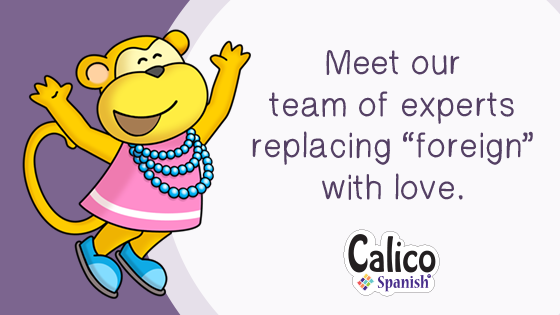
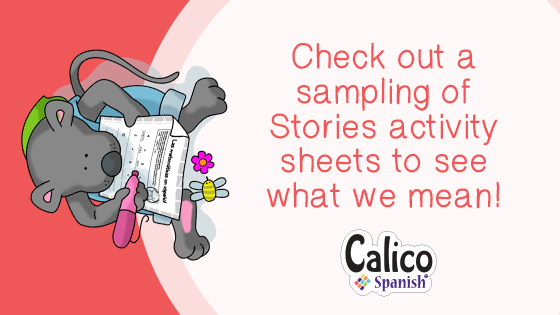
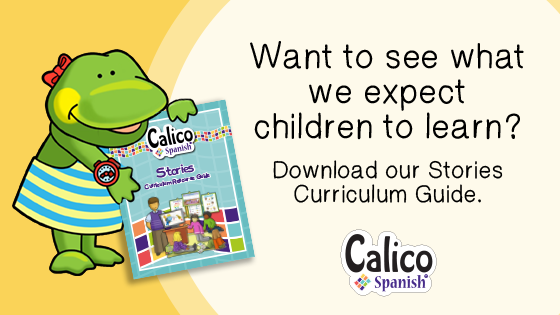
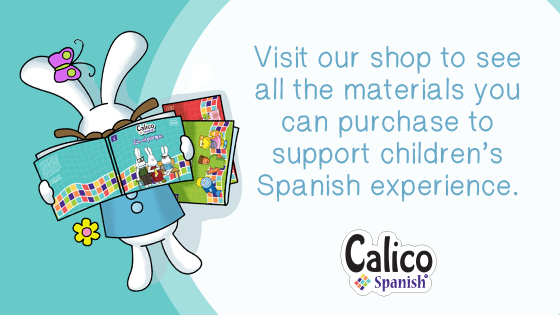
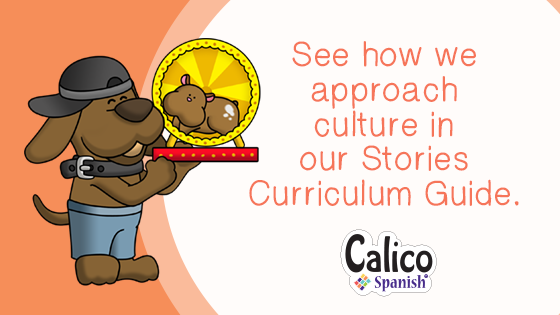
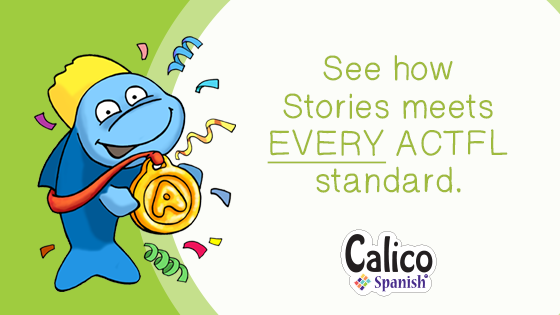
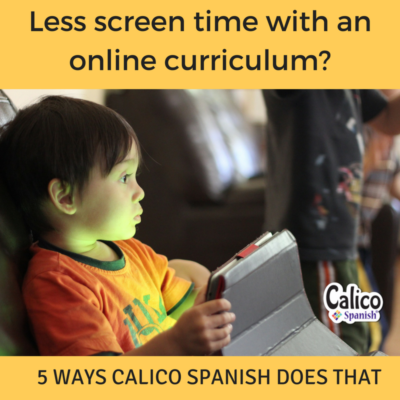


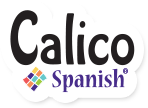
17 Comments
Is Calico Spanish suitble for middle scholers? Thank you.
Hi, Victoria, thanks for this question! Our program’s goals are great for all novice Spanish learners, but the animated Video Stories are most engaging for ages 5-9. Older children may feel too “sophisticated” for the animal cartoons, or they may love it – we have seen both reactions! Let us know if we can support you and your learners.
How many times a week do you suggest doing the Spanish lessons? Is daily recommended or can we do it once or twice a week?
Sara, we recommend doing three lessons per week, and that will take you through about a level a year. Of course, if you go slower it will last longer! Heads up that lesson plans in Level C and D can stretch to 30-45 minutes so you might do twice a week when you get there and it will take more like 3 years to do those two levels.
How do I see the videos .
I love your stories .
Maria Holmes
We’re so glad you love the stories, Maria! We invite you to explore the first full lesson at this page. There, you can sign up for a free trial to explore 8 full units for 7 days. You can also sing most of our songs and play many of our games anytime at this page. Enjoy the journey!
Is there a program that you recommend for further study after children have completed this one? And can you recommend a program for older children, who are beginning their studies but are a bit “old” for this program, that would maintain a similar teaching philosophy?
Hi Janelle, good question, we get this one a lot!
The only program I’ve seen that takes a similar approach with comprehensible, engaging video stories, but has an older-kid “feeL” to it, is Foreign Languages For Kids by Kids. It’s not as extensive and doesn’t have comprehensive supplemental activities or lesson plans that I’ve seen, but the video story approach is similar.
For after Stories, you might take a look at Middlebury Interactive. I know some teachers who have worked on that program and their teaching philosophy and approach are spot-on. Very standards-based. The problem with it in the early years is that it heavily relies on authentic materials – great if you can comprehend them, but not so great if you’re struggling to pick out comprehensible words in a sea of noise! Still, it can be a fit for kids who already have some Spanish skills.
is the curriculum possible for homeschooling a grade 3 student with zero knowledge of spanish and a non-spanish speaking parent? How many Levels is this program? how long to finish the program?
Hi Sheryl, great questions! Our program is actually designed to work for as many situations as possible- including families where the parent does not speak any Spanish. The lesson plans are open-and-go, and we provide translations so you always know what’s going on. Children ages 5-10 love our program, and those with no Spanish knowledge start with Level A. I encourage you to check out our homeschool info page here and sign up for a free trial here. There’s no obligation and you’ll be able to see 8 units for 7 days. Let us know if you have more questions!
I am excited to have found a curriculum that conforms to the ACTFL standards and that emphasizes comprehensible language input in contexts that are meaningful to young learners. The Stories look so fun and engaging!
I am curious if this program would be suitable for elementary teachers who have advanced proficiency in Spanish. If I were to implement the Calico curriculum, and if I chose to narrate the stories myself (rather than turning on the storybook videos), would my students have a lesser experience? That is, can the Calico curriculum have its full impact if all of the stories are presented in physical storybook form, with the teacher reading/narrating to her students?
I would appreciate advice on how to balance the screen time components (videos, songs, etc.) with real-person classroom interactions (physical storybooks, games, activities) given the fact that I am looking forward to speaking Spanish with my students and sharing my love of the language with them in person.
And one final question — I will be teaching about 400 students (preK through sixth grade) at two different elementary campuses, which means I will only be able to visit each homeroom for Spanish class once per week. Is Calico still a good choice for my school even if I am unable to provide the recommended three times per week exposure?
Thanks,
Rori
Hi Rori, we’re so glad to hear you’re looking to join the Calico family! We’ve worked hard to partner with teachers to provide meaningful, effective Spanish experiences for children and we can’t wait to be a part of your learners’ journey also.
The best experience for children is under a qualified, proficient Spanish teacher, so it’s great to hear you want to provide as much Spanish as possible for kids. With our storybook videos (the videos where a narrator reads the book), you’ll be able to mute the audio and read to the kids yourself, and that’s a great idea. (I believe kids will still benefit from the video stories where the animals interact with dialogue.) Just be sure to use strategies to make sure you’re comprehended, and the input will be great for them!
On your question about on-screen/off-screen balance, this is a common concern for us, too. We are doing an in-depth update to our lesson plans this summer and fall and you will see a whole lot more interactive activities within the lesson plans. Also, check out our blog post on ways to inspire more off-screen activity with an online curriculum.
On your final question – we wrote a blog post for that as well. I hope it helps!
Keep the questions coming!
Sara-Elizabeth
We loved your level A, but we’re in Canada and it’s more helpful to learn French as our second language. Do you know of any French resources that are similar? Do you have any plans to make curriculum for other languages too?
Hi! I am going to teach Spanish at an k-7th school and my classes will be 1hr long. I can’t really understand which packet to get and what each packet has. I would like to buy a curriculum that not only comes with the detailed lesson plans but also with all the material already printed. Since I will have elementary students and 6 and 7 (middle school students), could you please recommend me what to purchase (making sure that it comes with the lesson plans and materials)? I am a first year teacher and am having trouble choosing the right option.
Thank you so much!
Ms. Leon, thank you for reaching out! Congratulations on your upcoming first year of teaching. That’s very exciting! Our curriculum is charged on a subscription basis. Every subscription gives you complete access to our complete curriculum that fully covers a K-5 age range of Spanish comprehension.
In addition to the curriculum, many of our teachers often order our Visuals packs. The curriculum subscription comes with digital, printable copies of all the resources, but the Visuals packs offer physical copies of high-quality flashcards, storybooks, and posters that are handy to have in the classroom. If you want the physical copies of the resources, I’d recommend our 1-year curriculum subscription and our Visuals Bundle (Levels A, B, C, and D).
The Calico Spanish curriculum is geared towards a K-5 age range of kids. We’ve had schools use our curriculum for 6th and 7th graders with success. That being said, success with that older group is on a case-by-case basis based on their previous Spanish exposure and classroom demeanor. 6th and 7th graders can get bored with content that’s geared towards a younger audience. Please reach out to us at support@calicospanish.com if you have any further questions!
Hi, I’m a homeschool mum. My son is interested in learning Spanish, we are South African. I wonder are the online lessons live or recorded as I think the time zone difference would be an issue? Do you provide a report/assessments of some sort to show how what students have learned has aligned to a framework (this would help me with government oversight)
Thank you for reaching out, Bernadine! Our curriculum is designed to be taught by a parent or teacher who works alongside their learners through the lesson content. Our curriculum is split into 4 levels that cover a K-5 elementary age range, and there are milestones and assessments along the way for learners to achieve. We do not offer live or recorded lessons of our content, but the curriculum is designed to be taught by anyone, regardless of Spanish ability. Our Resource Library (available in your free trial! calicospanish.com/free-trial) is a great tool to check out to see how we set parents and teachers up for success. If you have any other questions, please don’t hesitate to reply here or to reach out to our support team at support@calicospanish.com. Thank you!